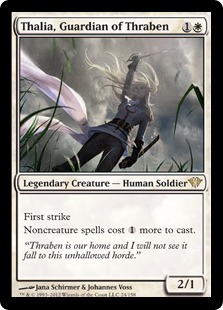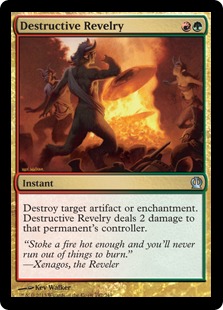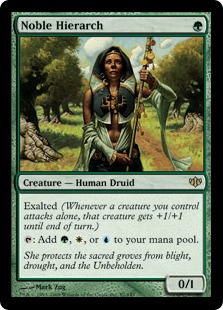Are you a Quiet Speculation member?
If not, now is a perfect time to join up! Our powerful tools, breaking-news analysis, and exclusive Discord channel will make sure you stay up to date and ahead of the curve.
Good news, everyone! Modern PPTQ season starts this week, and we have metagame data to work with! Jason has promised that the June update will happen tomorrow, but for today lets examine the first results from our new post-Eldritch Moon metagame. Frankly, I don't expect much to have changed, mostly because it was the release weekend and brewers haven't had enough time to refine their lists. However there were a number of cards that slotted into existing decks and the reaction of pilots to perceived changes always plays a factor, so you never know.

As always, it is important to remember that all the conclusions I'm reaching come from a very limited dataset. As such, any conclusions that I come to are reflective of the data itself and are not applicable to the metagame as a whole. A small dataset lacks the robustness to accurately reflect wider trends, but it gives us some insight into the thinking going into the event in question which can be useful as a starting point. I realize that the long-time Nexites have heard this disclaimer enough to repeat it themselves, but it's still important to keep in mind. Those of us who work with data dislike having our work used to make sweeping generalizations. Though we love situational irony.
[wp_ad_camp_1]
The Top 16
We have no coverage to provide specific insights into the tournament, but we do know that it was eight rounds long and we have the Top 16 decklists.
| Deck Name | Place |
|---|---|
| Affinity | 1 |
| Merfolk | 2 |
| GW Hatebears | 3 |
| Death and Taxes | 4 |
| Abzan | 5 |
| 5-Color Aggro | 6 |
| Burn | 7 |
| Jeskai Control | 8 |
| Esper Tokens | 9 |
| Living End | 10 |
| Jund | 11 |
| Eldrazi Taxes | 12 |
| Jeskai Control | 13 |
| Mardu Tokens | 14 |
| Ad Nauseam | 15 |
| Scapeshift | 16 |
Well, huh. There are 16 distinct decks in this Top 16. Not bad for diversity. Yes, I know Jeskai Control is listed twice but I assure you the decks are very different, as will be discussed below. Also worth noting is that none of the boogeymen from my article two weeks ago are present. Whether this is the metagame adjusting or a low population in Columbus I can't say for certain, but it does reassure me.
Interesting Results
 Interestingly, there are 11Thalia, Guardian of Thrabens in this Top 16, and all in very different decks. Given the prevalence it's not surprising to me that the combo decks are 15th and 16th place, but I find it surprising to see so many Taxes decks in the first place. DnT thrives in Legacy due to the degeneracy and velocity of the format, but Modern is typically more fair which make taxing cards less effective. This coupled with the linear aggressive decks has long kept this style of deck on the fringes of Modern. GW Hatebears usually overcomes this by playing larger creatures, but Brandon Semerau isn't playing Loxodon Smiter. Eldrazi and Taxes has gained ground thanks to the power of Reality Smasher, but Alexander Parsell didn't play a full set. All this put together makes me really want to know what was going on in total metagame in Columbus.
Interestingly, there are 11Thalia, Guardian of Thrabens in this Top 16, and all in very different decks. Given the prevalence it's not surprising to me that the combo decks are 15th and 16th place, but I find it surprising to see so many Taxes decks in the first place. DnT thrives in Legacy due to the degeneracy and velocity of the format, but Modern is typically more fair which make taxing cards less effective. This coupled with the linear aggressive decks has long kept this style of deck on the fringes of Modern. GW Hatebears usually overcomes this by playing larger creatures, but Brandon Semerau isn't playing Loxodon Smiter. Eldrazi and Taxes has gained ground thanks to the power of Reality Smasher, but Alexander Parsell didn't play a full set. All this put together makes me really want to know what was going on in total metagame in Columbus.
It would be remiss of me not to mention that Affinity won the tournament, taking down a mono-blue Merfolk list in the finals. I find Steven Martin's list interesting since it plays both Etched Champion and Master of Etherium when normally it's one or the other. Champion shines in fair, grindy metas while Master is an incredible clock against combo, and since Affinity doesn't want too many three-drops you usually see just one of these cards as a four-of, with four Galvanic Blast in the support slot, making Martin's 3-3-2 split intriguing. Obviously it worked, but I'd like to know whether this is because it is a finely tuned list or if he got by because sometimes Affinity is just Affinity.
The Winners
 Given the composition of the Top 8 and the bracket, I'm not surprised that Martin won. The only list that looks especially prepared for the robots is Patrick Narsavage's Burn deck with both Stony Silence and Destructive Revelry in the sideboard. That wasn't enough because Burn's matchup isn't very good against Affinity (I don't think it can beat a pumped Vault Skirge game one and just like Merfolk it really needs to hit its hate games two and three). Harbinger of the Tides is certainly useful against Affinity, but without a full set of Hurkyl's Recall, Dorian Finn was very unlikely to win. I play Stony Silence and Recall and still struggle, so I imagine that Finn had it worse. Martin was very well positioned for the Top 8 and performed as he should have, so well done.
Given the composition of the Top 8 and the bracket, I'm not surprised that Martin won. The only list that looks especially prepared for the robots is Patrick Narsavage's Burn deck with both Stony Silence and Destructive Revelry in the sideboard. That wasn't enough because Burn's matchup isn't very good against Affinity (I don't think it can beat a pumped Vault Skirge game one and just like Merfolk it really needs to hit its hate games two and three). Harbinger of the Tides is certainly useful against Affinity, but without a full set of Hurkyl's Recall, Dorian Finn was very unlikely to win. I play Stony Silence and Recall and still struggle, so I imagine that Finn had it worse. Martin was very well positioned for the Top 8 and performed as he should have, so well done.
The Top 8 bracket played out as I'd expect except for the match between Max Hersch on Death and Taxes and Maggie Normile with Abzan. Abzan outsizes DnT and Lingering Souls contains fliers very effectively so I think the match is in Abzan's favor. It's possible that Selfless Spirit blanked enough removal to win the game, but I never beat Abzan with DnT playing the attrition game. Mirran Crusader is another possible explanation, but Abzan has Path to Exile. As someone who has repeatedly tried to make DnT work in Modern, you can bet that I will be examining Hersch's list and trying it out for myself. While I'm at it I'll be testing this specific matchup to try to answer the above skepticism.
The Conclusion
This was a very fair Top 16. There is only one "fair" deck in Affinity and two unfair decks, Ad Nauseam and Living End, which makes the relative prevalence of Taxing decks unusual. We see a healthy number of policing decks alongside linear aggressive decks with less than fair decks in small numbers. Thus my conclusion is that the metagame adjusted against unfair decks in Columbus. Affinity scooted through thanks to a relative lack of preparedness and favorable pairings.
If I were to extrapolate from this result to the wider metagame, all I would conclude is that the potentially problematic decks are beatable. Had Infect appeared in large numbers despite all the removal present that would be alarming. Instead I must conclude that as long as players take reasonable precautions against "fair" and unfair decks then there should be no wider metagame warp.
Decks Worth Discussing
I know I'm hedging on my conclusions, but there's just not much data you can pull from a single tournament. The metagame updates will provide a much more complete picture and provide more guidance as the PPTQ season gets underway. However, what we can analyze in detail are the individual decklists, and Columbus provided plenty to talk about.
Jeskai Control
As I said above, according to Star City Games, Jeskai Control was the most represented archetype in Columbus. Star City is partially right, because while there are two Jeskai decks they are very different from each other.
Jeskai Control, Samuel Ball (8th, SCG Columbus Classic)
Jeskai Control, Ryan Hipp (13th, SCG Columbus Classic)
First thing is that Hipp's deck is actually Blue Moon splashing white for Nahiri and Lightning Helix. Second thing is that all that's missing from Ball's Jeskai Delver deck is the Delver of Secrets itself. Seriously, it's a very aggressive deck with a full set of Geist of Saint Traft and all the burn. I wouldn't consider it control but midrange at slowest. Hipp's deck is actual control, which makes the inclusion of Thing in the Ice interesting. This is a very uncommon inclusion, and I'm skeptical of it as a sweeper but it seems to work for Hipp.
I think it's instructive that Ball did better than Hipp. It's better to be proactive than reactive in Modern, and all Ball did was replace the sweepers and card advantage for a faster clock. I've long said that the Nahiri plan was very slow as a win condition, though I appreciate its other benefits. I imagine that Geist aggro carried Ball through a number of matches where Nahiri would have been inadequate, even if it is much worse against other creature decks. On the other hand, how many sweepers do you really need when you deck is a third removal? Despite assumptions, sometimes Geist beats Zoo on the basis of drawing removal for every potential blocker.
5-Color Aggro
Not a very evocative or descriptive name, but what would you call this monstrosity? Or as I call it, "Why Modern needs Blood Moon!"
5-Color Aggro, by Jack Rumpf (6th, SCG Columbus Classic)
Look at it. Look at it. It's like an Aristocrats deck T-boned Abzan and they just made it work. Rumpf's deck has a lot of interesting synergies, chiefly sacrificing Spell Queller to Falkenrath Aristocrat to permanently exile spells, but it also packs every good multicolored creature in Modern to just bury the opponent. Birds of Paradise into Mantis Rider followed by Siege Rhino is a very impressive curve and surprisingly hard for many decks to overcome. There's some disruption from the creatures but mostly it's a focused multicolored aggro deck that just plays good creatures.
 He has the full set of multicolor mana dorks for good reason. Even with all the five-color lands his manabase is unstable and his curve top-heavy, which is probably why he lost to Merfolk's stable mana and mana disruption. I don't see this deck reliably beating a deck that's capable of Bolting its birds and then playing its own game on curve. I imagine that Rumpf got through a combination of raw card power and surprise. I can't imagine that this style of deck will be terribly common, but it's an interesting and refreshing addition to the metagame.
He has the full set of multicolor mana dorks for good reason. Even with all the five-color lands his manabase is unstable and his curve top-heavy, which is probably why he lost to Merfolk's stable mana and mana disruption. I don't see this deck reliably beating a deck that's capable of Bolting its birds and then playing its own game on curve. I imagine that Rumpf got through a combination of raw card power and surprise. I can't imagine that this style of deck will be terribly common, but it's an interesting and refreshing addition to the metagame.
I called this deck "Why Modern needs Blood Moon" because five-color decks aren't particularly healthy for the format. There are so many powerful cards in the older formats and the mana so potentially perfect that if it weren't for powerful mana disruption the tendency would be to just play all the power cards in the same deck, which would push the format towards similar-looking "good-stuff" decks. Legacy has the better mana and the best disruption in Wasteland. Modern has nothing on the scale of Wasteland, so we need Blood Moon to protect against these types of decks.
Esper Tokens
When I first looked at the results from Columbus, I thought I would be congratulating Trevor for having his deck make Top 16, very likely missing Top 8 on tiebreakers. Then I actually checked the list and it's really not an Esper list in the same vein as he described.
Esper Tokens, by Mario Lillard (9th, SCG Columbus Classic)
Rather than being a control deck as Trevor describes, this deck appears to be a mashup of Esper Control and Tokens. Which I approve of. BW Tokens is a weird deck to me. Its hand disruption and light removal package suggest that it plays like an aggro-control or midrange deck, but the clock is so slow that it wins at control speed. It's very good at going over the head of midrange decks; it's very easy for aggro decks to get under it or control decks to overpower the clock and win with card advantage.
Taking out the anthems and adding more control elements gives the deck a stronger identity and a better matchup against aggro. Lingering Souls on its own is good enough against most midrange decks that I really don't think the anthems are necessary outside of dedicated Tokens. The many one-ofs are weird to me since there isn't any card draw or selection besides the single Sphinx's Revelation, but I might be overly cautious.
It reminds me of some of my first attempts to make Monastery Mentor work. This in turn is making me want to bang my head against that wall again. In the end this deck makes me feel conflicted: I like the idea behind it but now I have to stop myself from trying out my bad ideas. Again.
Looking Forward
I plan on getting back on the PPTQ grind this weekend, so expect more tournament reports and deck analysis in the coming weeks. Personally I hope that the results from SCG Columbus are indicative of the Modern metagame. Worrying about Amulet Bloom all last season was frustrating and the decks I prefer do better in fair metagames. So to all my fellow grinders, I hope you qualify at a tournament I'm not at!





I’m surprised you didn’t do a comparison between the Mardu Tokens and Esper Tokens lists, as both seem to be going for similar angles even if the individual card choices differ significantly.
It was cut for space. Shortened version: the Mardu list is very much an aggressive midrange deck while Esper is control. The combination of Mentor and Pyromancer allow the deck to amass a large army quickly which coupled with the burn makes for a very fast clock. The problem that I have is Pyromancer and Mentor are very vulnerable in Modern and Mardu is close to all in on the creatures, so it’s not as resilient as the Esper list.
But the fact that it top 8’d means it must be viable to some degree, which means that the decks threat base and resiliency issues can be overcome. I play Mardu tokens so I am a bit biased. My biggest difference is cutting YP and mentor for different token making threats with higher resiliency, bitterblossom and Brimaz. I dont know if this is better, but it does address some of the threat resiliency issues this Mardu build has.
As a D&T player i see, from the top 16, a lot of decks that have disruptable mana bases with leonin arbiter + GQ. Thalia can definitely be annoying for these spell-heavy decks, and if you cut them off of one color things can get ugly for them.
I wonder if Arbiter + GQ as a package could be slotted in more decks than just DnT.
How did mantis rider join modern? I am seing more and more decks that uses creatures that do not pass the bolt test. Are we enterign a paradigem shift? Or perhaps the bolt test is wrong?
Last time I saw the mantis rider in modern it was with some crusades in it.
i don’t understand the Spell Queller and Falkenrath Aristocrat interaction. wouldn’t sacrificing Spell Queller trigger the “when Spell Queller leaves the battlefield, exiled spell is cast”?
The way Spell Queller and Tidehollow Sculler work is that there are two linked triggers, one when the card enters and one when it leaves the battlefield. When it enters the battlefield the first trigger goes on the stack. If it leaves the battlefield before that first trigger resolves the leaves the battlefield trigger goes on the stack and when it resolves it has nothing to return. Thus when the first trigger resolves the card is exiled forever as the linked return trigger has already resolved and cannot trigger for that exiled card again.
sounds like a loophole in the rules that might be fixed with errata in future. tbh, i really don’t think when they updated the stack rules back in 6th edition, they intended for this to work this way.
but thanks for the clarification!
This interaction with the stack has been known with many cards and for a long while: Tidehollow Sculler, Fiend Hunter, Brain Maggot, Banisher Priest ect.
I doubt they are going to change it anytime soon.
To be clear – Brain Maggot and Banisher Priest don’t work like this. Sculler and Hunter have 2 triggers (ETB and LTB), Priest and Maggot – only one, delayed trigger (or to be more precise – zone-change effect with limited duration).
I agree with the rest of Ur post tho
Well it doesn’t actually work with brain maggot or banisher priest because they have the newer wording with only one trigger. But for spell queller I guess they couldn’t find a way to word it similarly so they reverted to the “old” wording.
So happy to see living end up there!
The deck chrashed so hard after the eldrazi winter and i feel like more decks are removing some sideboard hate against graveyards.
Good article, David. I agree with you regarding the Jeskai list with Geist being midrange as opposed to control, and that Esper Tokens list looks pretty spicy. Not sure what to make of it just yet, as I haven’t really encountered something that truly approximates it.
As for the reason why we saw 2 distinct D&T lists while unfair decks were seemingly on the decline, my theory is that Eldritch Moon has improved the card pool for the deck (via the introduction of Selfless Spirit and – to a lesser extent – the new Thalia), and that has given it more legs in an all-comers metagame. I’m hoping that my assessment is correct, as I’ve always been rather fond of the deck (Vial buddies stick together), and would like to see it do well.
SCG again killing us with its nondescript deck names. Those Jeskai decks are generally referred to, respectively, as “Jeskai Geist” or “Geist of Saint Win” (incidentally one of the more obvious misnomers of our time) and “Jeskai Moon.”
Amazing that they called the Bitterblossom deck “Esper Control.” All in a day’s work!